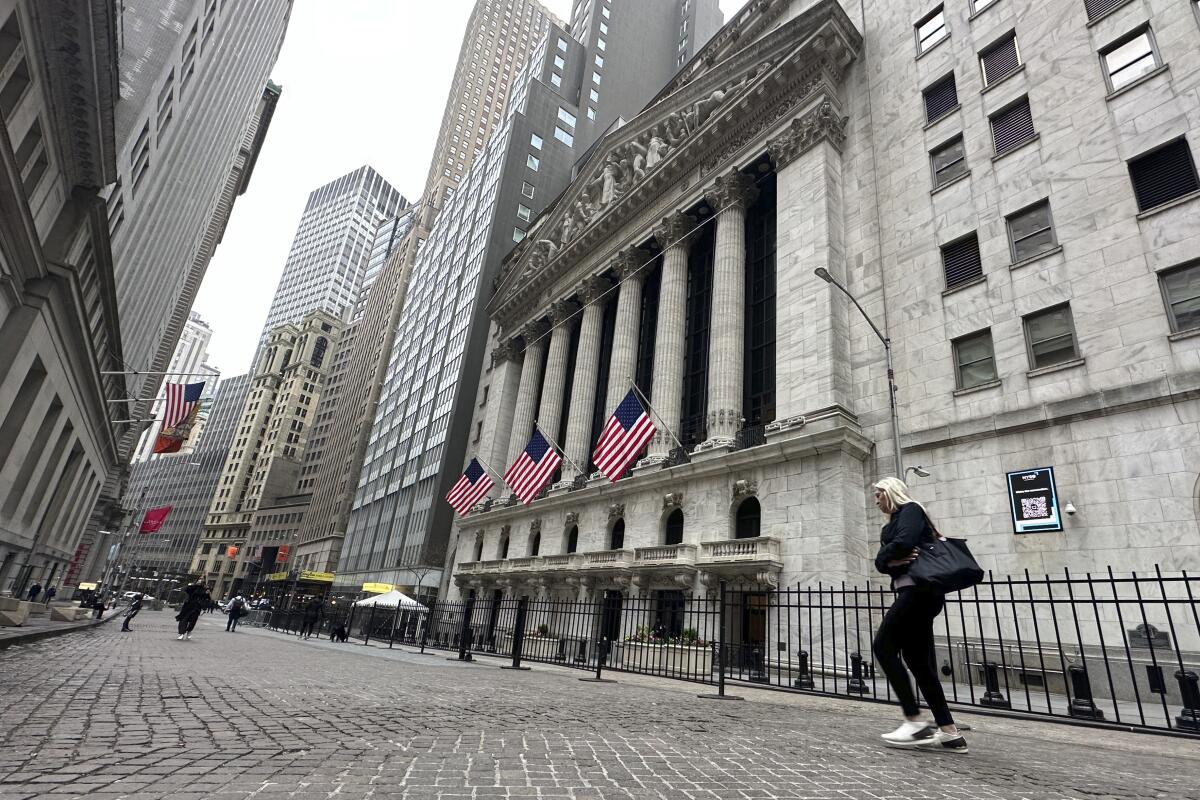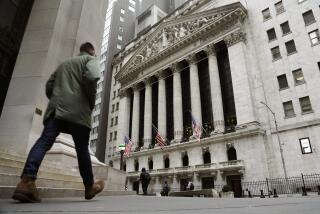Wall Street’s ugly April gets even worse as it tumbles across the finish line

- Share via
NEW YORK — More worries about inflation and interest rates staying high knocked U.S. stocks lower on Tuesday as the market closed out its worst month since September.
The Standard & Poor’s 500 tumbled 1.6% to cement its first losing month in the last six. Its momentum slammed into reverse in April, falling as much as 5.5% at one point, after setting a record at the end of March.
The Dow Jones industrial average dropped 570 points, or 1.5%, and the Nasdaq composite lost 2%.
Stocks began sinking as soon as trading began, after a report showed U.S. workers won bigger gains in wages and benefits than expected during the first three months of the year. While that’s good news for workers and the latest signal of a solid job market, it feeds into worries that upward pressure remains on the economy and inflation.
It followed a string of reports this year that have shown inflation remains stubbornly high. That has caused traders to largely give up on hopes that the Federal Reserve will deliver multiple cuts to interest rates this year. And that in turn has sent Treasury yields jumping in the bond market, which has cranked up the pressure on stocks.
Tuesday’s losses for stocks accelerated at the end of the day as traders made their final moves before closing the books on April, and ahead of an announcement by the Federal Reserve on interest rates scheduled for Wednesday afternoon.
No one expects the Federal Reserve to change its main interest rate at this meeting. But traders are anxious about what Fed Chair Jerome H. Powell may say about the rest of the year.
Traders are now mostly betting the Fed will cut rates either one or zero times through the balance of 2024, according to data from CME Group. That’s a big letdown after traders came into the year forecasting six or more cuts.
The Fed itself was earlier penciling in three cuts to rates during 2024, but top officials have recently hinted that rates may stay high for longer as they wait for more confirmation inflation is heading down toward their 2% target. The Fed’s main interest rate is sitting at the highest level since 2001, which puts downward pressure on the economy and investment prices.
Without the benefit of easing interest rates, companies will need to deliver bigger profits in order to support their stock prices, which critics have called broadly too expensive following their run to records.
GE Healthcare Technologies tumbled 14.3% after it reported weaker results and revenue for the latest quarter than analysts expected. F5 dropped 9.2% despite reporting a better profit than expected. Its revenue fell short of forecasts, and it said customers were remaining cautious and forecasting largely flat IT budgets for the year.
McDonald’s slipped 0.2% after its profit for the latest quarter came up just shy of analysts’ expectations. It was hurt by weakening sales trends at its franchised stores overseas, in part by boycotts from Muslim-majority markets over the company’s perceived support of Israel.
Helping to keep the market’s losses in check was 3M, which rose 4.7% after reporting stronger results and revenue than forecast. Eli Lilly climbed 6% after turning in a better profit than expected on strong sales of its Mounjaro and Zepbound drugs for diabetes and obesity. It also raised its forecasts for revenue and profit for the full year.
All told, the S&P 500 fell 80.48 points to 5,035.69. The Dow dropped 570.17 points to 37,815.92, and the Nasdaq composite fell 325.26 points to 15,657.82.
This earnings reporting season has largely been better than expected so far. Not only have the tech companies that dominate Wall Street done well, but so have companies across a range of industries.
That’s a change from the recent past, and it helped push strategists at Deutsche Bank to raise their forecast for full-year earnings growth for the S&P 500. Many companies are topping forecasts because they’ve been able to wring more profit out of each dollar of revenue than analysts were expecting, according to Binky Chadha, chief strategist at Deutsche Bank.
Such strength could support stock prices even if interest rates end up staying high, according to Kristy Akullian, head of iShares Investment Strategy, Americas.
“Equities don’t need Fed rate cuts for the rally to continue, all they need is solid earnings growth,” she said.
In the bond market, the yield on the 10-year Treasury rose to 4.68% from 4.61% just before the morning release of the report on employee wages and benefits.
The two-year Treasury yield, which more closely tracks expectations for the Fed, jumped back above the 5% level to 5.03% from 4.97% late Monday.
In stock markets abroad, Japan’s Nikkei 225 rose 1.2% after reopening following a holiday. The government reported stronger-than-expected gains in industrial production for March.
Indexes were mixed across much of the rest of Asia but lower in Europe.
Choe writes for the Associated Press
More to Read
Inside the business of entertainment
The Wide Shot brings you news, analysis and insights on everything from streaming wars to production — and what it all means for the future.
You may occasionally receive promotional content from the Los Angeles Times.










